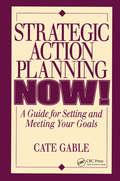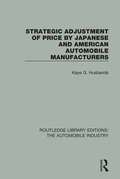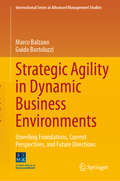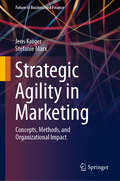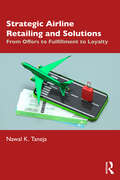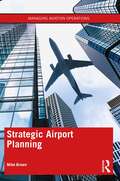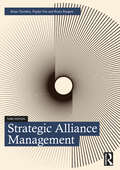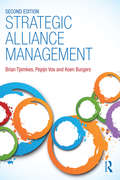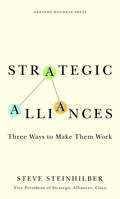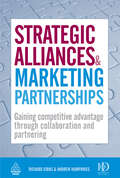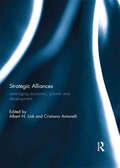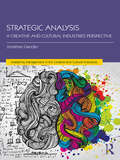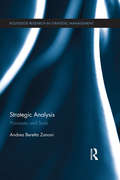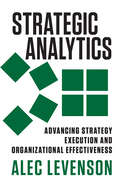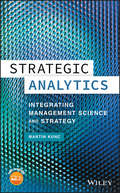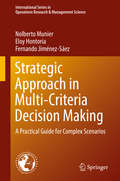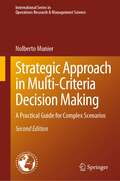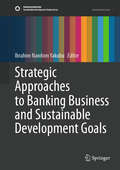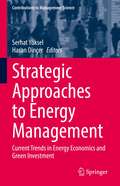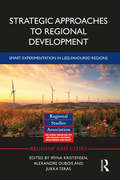- Table View
- List View
Strategic Action Planning Now Setting and Meeting Your Goals
by Cate GableFilling the need for a "how-to," step-by-step guide to strategic planning, Strategic Action Planning NOW! outlines team-based planning in four steps. Gate Gable's techniques provide detailed guidance into planning processes, strategic skills, recognition of challenges, consideration of goals, monitoring and measurement, and implementation tips to help the reader begin the planning process almost immediately.Written in three parts, the author provides exercises with each chapter. Part one covers the pre-planning stages, defining who and what your team is and what your teams' goals are. The second part goes over the actual planning, identifying the challenges and setting the goals for your team. The third and final part deals with post planning, implementation and evaluating your team's progress.
Strategic Activity-Based Management: Customers
by Robert S. Kaplan Robin CooperAnalysis reveals that many demands for organizational resources arise not only from products but also from customers and distribution and delivery channels. When we have even a rough economic map of our customer profitability, we have enormous opportunities for profit improvement. This chapter covers the wide variety of actions managers can take to transform unprofitable customers into profitable ones through initiatives on pricing, technology, ordering, and distribution.
Strategic Activity-Based Management: Product Mix and Pricing
by Robert S. Kaplan Robin CooperMany Activity-Based Management (ABM) practitioners focus only on operational ABM. They leave an important weapon unused when they ignore strategic ABM. This chapter introduces strategic activity-based management, which modifies the demand for organizational activities to enhance profitability. Focusing on decisions made about existing products, the product-related activities described, if implemented successfully, will reduce the resources required to produce products.
Strategic Activity-Based Management: Supplier Relationships and Product Development
by Robert S. Kaplan Robin CooperLarge opportunities for cost savings can come from upstream operations. By understanding the costs associated with ordering, receiving, inspecting, moving, storing, and paying for materials, companies can make better decisions in choosing the lowest total cost suppliers, not just the lowest price suppliers. Upstream operations in time give managers the best opportunities for cost reduction during product design and development. This chapter extends strategic activity-based management (ABM) back in the value chain to suppliers and to product designers and developers.
Strategic Adjustment of Price by Japanese and American Automobile Manufacturers (Routledge Library Editions: The Automobile Industry)
by Kaye G. HusbandsThis book, originally published in 1993, develops for the US automobile industry a demand-supply model which incorporates both wholesale and retail sectors and which allows strategic pricing behaviour of US and Japanese producers to be internally determined and its effects on market behaviour and national welfare analyzed. It develops the framework for and presents the results of an econometric simulation of the transaction and wholesale prices, quantities demanded and produced, manufacturer's costs and factor demands. The impact of the Voluntary Export Restraint of 1981 on profits and consumer welfare are generated from the simulation results.
Strategic Agility in Dynamic Business Environments: Unveiling Foundations, Current Perspectives, and Future Directions (International Series in Advanced Management Studies)
by Marco Balzano Guido BortoluzziStrategic agility is a fast-growing paradigm for strategic thinking and strategy-making that is finding increasing acceptance both in academia and practice. But what are the theoretical origins of this paradigm? What are the main lines of development of the paradigm in the current academic debate and in firms adopting agile strategies? And, finally, what are the areas and topics that need additional research? With this book, Guido Bortoluzzi and Marco Balzano take us first into the past to look for the historical roots of this disruptive paradigm, then review the current academic debate on the topic and present some cases of agile companies. And finally, they discuss the potential future development of this topic in the field of strategy research.
Strategic Agility in Marketing: Concepts, Methods, and Organizational Impact (Future of Business and Finance)
by Jens Kröger Stefanie MarxThis book offers a comprehensive guide to establishing marketing organizations and teams based on Agile principles. By emphasizing a customer-centric mindset, flexible structures, cross-functional collaboration, and continuous success measurement, agility empowers marketing teams to strengthen customer relationships, foster innovation, and amplify organizational impact. When implemented effectively, agile marketing positions teams as true business enablers within their organizations. In light of recent global challenges—such as the pandemic, economic shifts, and rapid technological advancements—the need for adaptability has become more critical than ever. This book delves into developing an agile mindset, values, and principles while providing practical methods and tools for operationalizing agile marketing. Readers will gain insights into positioning marketing as a strategic business enabler and thriving in dynamic environments, transforming marketing into a key success factor for their organizations. Targeted at marketing professionals, business leaders, and academics, this book is an essential resource for anyone looking to leverage agility to gain a competitive edge in today&’s fast-changing world.
Strategic Airline Retailing and Solutions: From Offers to Fulfillment to Loyalty
by Nawal K. TanejaWhile airlines have been looking into the next generation of retailing practices for several years, developments since the beginning of 2020 have accelerated the need to take retailing to a new paradigm. A singular focus now is the ever-changing demands of the current and next generation of customers and employees and managing their values. Examples of customer needs include a mobile-first approach, rich content, augmented and personalized end-to-end services with seamless, consistent, and contextualized experiences. While these concepts of retailing are not new, the challenge has been in bringing them to reality due to (a) the constraints of legacy systems and processes while transitioning to next-generation retailing systems, (b) the inaccessibility of real-time data coming from a wide variety of sources such as online shopping, social media, and operations, (c) the inability to monitor real-time behavior of customers and employees, (d) the lack of effective collaboration and cooperation within the travel ecosystem, and (e) the increasing lack of trust on the part of customers. This book provides a framework and technologies to convert retailing concepts—from shopping to fulfillment—into reality by (a) renovating an airline’s core and ancillary products, (b) progressing faster on digital and organizational transformation journeys to make better data-based decisions about retailing, (c) getting better at managing customer value by knowing who the customers are, (d) empowering, supporting, and listening to employees to meet their expectations, (e) asking the right questions to solve complex retailing problems relating to customers, competitors, and stakeholders, and (f) questioning common-held beliefs about the airline business. This book is indispensable for all airline executives and senior managers, as well as airline and airport commercial managers. It will also be enormously beneficial for retailers dealing with airlines and airports.
Strategic Airport Planning (Managing Aviation Operations)
by Mike BrownThis book will explore a new approach to airport planning that better captures the complexities and velocity of change in our contemporary world. As a result, it will lead to higher performing airports for users, business partners, investors and other stakeholders. This is especially pertinent since airports will need to come back better from the Covid-19 pandemic. The book explains the importance of articulating a clear strategy, based on a rigorous analysis of the competitive landscape while avoiding the pitfalls of ambiguity and ‘virtue signalling’. Having done so, demand forecasts can be developed that resemble S-curves, not simple straight lines, that reflect strategic opportunities and threats from which a master plan can be developed to allocate land and capital in a way that maximizes return on assets and social licence. The second distinctive feature of this book is the premise that planning an airport as an island, a fortress even, does not work anymore given how interconnected airports are with other components of the transportation system, the economies and communities they serve and the rapid pace of social and technological change. In summary, the book argues that airport planning needs to move beyond its traditional boundaries. The book is replete with real examples from airports of all sizes around the world and includes practical advice and tools for executives and managers. It is recommended reading for individuals working in the airport business or the broader air transport industry, members of airports’ board of directors, who may be new to the business, elected officials, policy makers and urban planners in jurisdictions hosting or adjacent to airports, regulators, economic development professionals and, finally, students.
Strategic Alliance Management
by Brian Tjemkes Pepijn Vos Koen BurgersStrategic Alliance Management presents an academically grounded alliance development framework, detailing eight stages of alliance development with consideration for specific management challenges. For each stage, readers are presented with theoretical insights, evidence-based managerial guidelines and a business case illustration. Other chapters consider alliance attributes, alliance competences, and alliance challenges, and cover topics such as innovation, co-branding, co-opetition, business ecosystems, alliance professionals, alliance capabilities, societal alliances and a tension-based alliance mindset. This fully revised 3rd edition leverages the book’s strengths in marrying theory with practical insight. All the chapters have been updated to reflect the current academic literature, whilst new international case studies are incorporated throughout. Two new chapters feature in this edition, considering the importance of the mindset required to successfully navigate alliance arrangements, and emerging alliance practices, exploring how new technologies, sustainability and the external environment have disrupted alliance management. In-chapter text boxes discussing emerging themes provide opportunity for discussion and analysis. The textbook remains highly valuable core and recommended reading for postgraduate students of Strategic Management and Corporate Strategy, MBA and Executive MBA, as well as reflective practitioners in the field. Online resources include chapter-by-chapter lecture slides, two long case studies and short interviews with alliance executives.
Strategic Alliance Management
by Brian Tjemkes Pepijn Vos Koen BurgersStrategic alliances – partnerships between separate organizations to share resources collaboratively toward mutually beneficial goals – are an important management instrument, but one that is difficult for firms to manage. Among many desirable outcomes, alliances can reduce costs, provide access to new technology, and improve research and development endeavours, though collaborative arrangements come with risks, peril, and adversities. This renewed and re-worked text connects theory to practice to help understand this important business practice. Strategic Alliance Management presents an academically grounded alliance development framework, detailing eight stages of alliance development with consideration for specific management challenges. For each stage, readers are presented with state-of-the-art theoretical insights, evidence-based managerial guidelines and a business case illustration. Additional chapters detail on contemporary alliance management challenges, including co-opetition and business eco-systems. Other chapters highlight the role of alliance professionals, alliance capabilities and paradoxical challenges in alliance relationships. This second edition retains a blend of academic knowledge and practical examples, while updating case examples and adding five new chapters on emerging alliance topics. This book remains vital reading for business students and professionals interested in strategic management.
Strategic Alliances
by Steve SteinhilberAs a top executive, you've almost certainly forged strategic alliances with other companies. Some of these deals have worked--but many others have likely failed. In fact, companies worldwide launch more than two thousand strategic alliances every year, and more than half never deliver as promised.In Strategic Alliances, Steve Steinhilber proves that, despite the odds, alliances are critical to the business strategy for companies competing globally: customers want integrated solutions to their problems, and that's pushing companies to work together to create differentiated offerings. Equally crucial, well-managed alliances generate important forms of business value, including new products and accelerated growth.Drawing on his experience as the head of Cisco's Strategic Alliances group, Steinhilber has created tools and guidelines that will help you forge alliances that work. He describes the three essential building blocks of successful alliances and explains how to establish:The right framework--by articulating how an alliance will help you achieve your company's strategic business goals and identifying potential partnersThe right organization--by staffing your alliance organization with the right people and constantly honing their skillsThe right relationships--by cultivating trust among the many key internal contacts in your organization and your alliance partnersEngaging and authoritative, Strategic Alliances shows you how to manage strategic partnerships more effectively and maximize their value in a complex and changing business environment.From our new Memo to the CEO series--solutions-focused advice from today's leading practitioners.
Strategic Alliances and Marketing Partnerships: Gaining Competitive Advantage Through Collaboration and Partnering
by Richard Gibbs Andrew HumphriesStrategic Alliances and Marketing Partnerships will help you to understand how partnerships function and how you can manage them more effectively and efficiently. Based on solid research and dealing with key topics such as supply chain management, marketing channels and relationship management, it identifies the key factors that determine partnering excellence. Whatever the nature of the relationship - whether outsourcing, strategic alliances or co-manufacturing, there are eight distinctive relationship types identified by the authors to help managers optimize their business to business partnerships.With case studies from prominent, global organizations such as Walmart, Toyota, General Motors and Dell, Strategic Alliances and Marketing Partnerships will help you to understand the problems that affect partnering and how to make effective management decisions to improve both the relationship and productivity.
Strategic Alliances: Leveraging Economic Growth and Development
by Albert N. Link and Cristiano AntonelliStrategic alliances have generally been used to refer to relationships that allow an organization to access the strengths and capabilities of other organizations, with the organization often focused on being the firm. The strategy behind such an alliance is for each firm in the alliance to draw on the core competencies of the other firm(s) with the goal of facilitating the growth and development of each member. Strategic alliances have long been studied from several perspectives, including the way in which the alliance is brought about, alternative forms of relationships that form the structure of the alliance, efficiency gains from the alliance, and the life cycle of the alliance. The strategic alliances that are now being observed are those that involve partners other than firms. In many advanced nations, strategic alliances are subsidized by the public sector in the belief that they advance economic growth. One such form of this public/private partnership involves universities as the public partner; another form involves a government agency as the public partner; and a third form involves both.This book transcends the traditional approach to a strategic alliance. As such, this collection might represent the locus of observational points that make up a new frontier, re-defining the scope of research that falls under the rubric of ‘strategic alliances’. This book was originally published as a special issue of Economics of Innovation and New Technology.
Strategic Analysis: A Creative and Cultural Industries Perspective
by Jonathan GanderThough their primary concern, organizations in the creative industries don’t only succeed or fail based on the exercise of their creative resources. Their fortunes also depend on their understanding and approach to the problem of competition.?? In Strategic Analysis: A creative and cultural industries perspective, Jonathan Gander offers a much needed introduction to how the practice of strategic thinking and analysis can be applied to this diverse and dynamic field. The book employs a range of competitive scenarios and case studies in which to practically apply a recommended set of analytical frameworks and examine the strategic challenge facing the enterprise and the wider sector. This concise and practical text focuses on providing a clear series of steps through which to identify and tackle strategic issues facing an enterprise, making it perfect reading for students and practitioners in the creative sector who seek a strategic understanding of the competition they are involved in.
Strategic Analysis: Processes and Tools (Routledge Research in Strategic Management)
by Andrea Beretta ZanoniIn the last few years, competition has become increasingly more complex, variable and dynamic, as can be seen in phenomena like globalization and technological acceleration. To cope with the dynamism and uncertainty of competition, enterprises need capabilities that enable them to respond to competition, as well as to improve their analytical skills and knowledge in order to better manage new strategic projects. Strategic analysis uses both quantitative and qualitative tools to understand both competitive contexts and available company resources. In Strategic Analysis: Processes and Tools, author Andrea Beretta Zanoni develops a theory of strategic analysis and offers models for the application of strategic analysis tools during all phases of the process including planning and decision-making, the development of control, and the formulation of a strategic diagnosis.
Strategic Analytics: Advancing Strategy Execution and Organizational Effectiveness
by Alec LevensonMore than ever, data drives decisions in organizations—and we have more data, and more ways to analyze it, than ever. Yet strategic initiatives continue to fail as often as they did when computers ran on punch cards. Economist and research scientist Alec Levenson says we need a new approach. The problem, Levenson says, is that the business people who devise the strategies and the human resources people who get employees to implement them use completely different analytics. Business analytics can determine if operational priorities aren't being achieved but can't explain why. HR analytics reveal potentially helpful policy and process improvements but can't identify which would have the greatest strategic impact. This book shows how to use an integrated approach to bring these two pieces together. Levenson presents a thorough and realistic treatment of the reasons for and challenges of taking an integrated approach. He provides details on the different parts of both enterprise and human capital analytics that have to be conducted for integration to be successful and includes specific questions to ask, along with examples of applying integrated analytics to address particular organizational challenges.Effective analytics is a team sport. Levenson's approach allows you to get the deepest insights by bringing people together from both the business and HR perspectives to assess what's going on and determine the right solution.
Strategic Analytics: Integrating Management Science and Strategy
by Martin KuncDefines common ground at the interface of strategy and management science and unites the topics with an original approach vital for strategy students, researchers and managers Strategic Analytics: Integrating Management Science and Strategy combines strategy content with strategy process through the lenses of management science, masterfully defining the common ground that unites both fields. Each chapter starts with the perspective of a certain strategy problem, such as competition, but continues with an explanation of the strategy process using management science tools such as simulation. Facilitating the process of strategic decision making through the lens of management science, the author integrates topics that are usually in conflict for MBAs: strategy and quantitative methods. Strategic Analytics features multiple international real-life case studies and examples, business issues for further research and theory review questions and exercises at the end of each chapter. Strategic Analytics starts by introducing readers to strategic management. It then goes on to cover: managerial capabilities for a complex world; politics, economy, society, technology, and environment; external environments known as exogenous factors (PESTE) and endogenous factors (industry); industry dynamics; industry evolution; competitive advantage; dynamic resource management; organisational design; performance measurement system; the life cycle of organisations from start-ups; maturity for maintaining profitability and growth; and finally, regeneration. Developed from the author's own Strategy Analytics course at Warwick Business School, personal experience as consultant, and in consultation with other leading scholars Uses management science to facilitate the process of strategic decision making Chapters structured with chapter objectives, summaries, short case studies, tables, student exercises, references and management science models Accompanied by a supporting website Aimed at both academics and practitioners, Strategic Analytics is an ideal text for postgraduates and advanced undergraduate students of business and management.
Strategic Analytics: Integrating Management Science and Strategy
by Martin KuncDefines common ground at the interface of strategy and management science and unites the topics with an original approach vital for strategy students, researchers and managers Strategic Analytics: Integrating Management Science and Strategy combines strategy content with strategy process through the lenses of management science, masterfully defining the common ground that unites both fields. Each chapter starts with the perspective of a certain strategy problem, such as competition, but continues with an explanation of the strategy process using management science tools such as simulation. Facilitating the process of strategic decision making through the lens of management science, the author integrates topics that are usually in conflict for MBAs: strategy and quantitative methods. Strategic Analytics features multiple international real-life case studies and examples, business issues for further research and theory review questions and exercises at the end of each chapter. Strategic Analytics starts by introducing readers to strategic management. It then goes on to cover: managerial capabilities for a complex world; politics, economy, society, technology, and environment; external environments known as exogenous factors (PESTE) and endogenous factors (industry); industry dynamics; industry evolution; competitive advantage; dynamic resource management; organisational design; performance measurement system; the life cycle of organisations from start-ups; maturity for maintaining profitability and growth; and finally, regeneration. Developed from the author's own Strategy Analytics course at Warwick Business School, personal experience as consultant, and in consultation with other leading scholars Uses management science to facilitate the process of strategic decision making Chapters structured with chapter objectives, summaries, short case studies, tables, student exercises, references and management science models Accompanied by a supporting website Aimed at both academics and practitioners, Strategic Analytics is an ideal text for postgraduates and advanced undergraduate students of business and management.
Strategic Appraisal
by Zalmay Khalilzad Jeremy ShapiroChange--in international relations, in technology, and in society as a whole--has become the idiom of our age. One example of these changes has been an increasing recognition of the value of air and space assets for handling nearly every contingency from disaster relief to war and, onsequently, increasing demand for such assets. These developments have created both challenges and opportunities for the U.S. Air Force. This, the fourth volume in the Strategic Appraisal series, draws on the expertise of researchers from across RAND to explore both the challenges and opportunities that the U.S. Air Force faces as it strives to support the nation's interests in a challenging technological and security environment.Contributors examine the changing roles of air and space forces in U.S.national security strategy, the implications of new systems and technologiesfor military operations, and the role of nuclear weapons in U.S. securitystrategy. Contributors also discuss the status of major modernizationefforts within the Air Force, and the bill of health of the Air Force, asmeasured by its readiness to undertake its missions both today and in thefuture.
Strategic Approach in Multi-Criteria Decision Making: A Practical Guide for Complex Scenarios (International Series in Operations Research & Management Science #275)
by Nolberto Munier Eloy Hontoria Fernando Jiménez-SáezThis book examines multiple criteria decision making (MCDM) and presents the Sequential Interactive Modelling for Urban Systems (SIMUS) as a method to be used for strategic decision making. It emphasizes the necessity to take into account aspects related to real world scenarios and incorporating possible real life aspects for modelling. The book also highlights the use of sensitivity analysis and presents a method for using criteria marginal values instead of weights, which permits the drawing of curves that depicts the variations of the objective function due to variations of these marginal values. In this way it also gives quantitative values of the objective function allowing stakeholders to perform a comprehensive risk analysis for a solution when it is affected by exogenous variables. Strategic Approach in Multi-Criteria Decision Making: A Practical Guide for Complex Scenarios is divided into three parts. Part 1 is devoted to exploring the history and development of the discipline and the way it is currently used. It highlights drawbacks and problems that scholars have identified in different MCDM methods and techniques. Part 2 addresses best practices to assure quality MCDM process. Part 3 introduces the concept of Linear Programming and the proposed SIMUS method as techniques to deal with MCDM. It also includes case studies in order to help document and illustrate difficult concepts, especially related to demands from a scenario and also in their modelling. The decision making process can be a complex task, especially with multi-criteria problems. With large amounts of information, it can be an extremely difficult to make a rational decision, due to the number of intervening variables, their interrelationships, potential solutions that might exist, diverse objectives envisioned for a project, etc. The SIMUS method has been designed to offer a strategy to help organize, classify, and evaluate this information effectively.
Strategic Approach in Multi-Criteria Decision Making: A Practical Guide for Complex Scenarios (International Series in Operations Research & Management Science #351)
by Nolberto MunierThis book examines multiple criteria decision making (MCDM) and presents the Sequential Iterative Modelling for Urban Systems (SIMUS) as a method to be used for strategic decision making. It emphasizes the necessity to take into account aspects related to real world scenarios and incorporating possible real-life aspects for modelling. The book also highlights the use of sensitivity analysis and presents a method for using criteria marginal values instead of weights, which permits the drawing of curves that depicts the variations of the objective function due to increments/decrements of criteria values. In this way, it also gives quantitative values of the objective function allowing stakeholders to perform a comprehensive risk analysis for a solution when it is affected by exogenous variables. Strategic Multi-Criteria Decision Making: A Practical Guide for Complex Scenarios is divided into four parts. Part 1 is devoted to exploring the history and development of the discipline and the way it is currently used. It highlights drawbacks and problems that scholars have identified in different MCDM methods and techniques. Part 2 refers to what can be done using the MCDM process. Part 3 proposes the SIMUS method as a strategic procedure to deal with MCDM problems, and addressing how to approach complicate scenarios. Part 4 is entirely devoted to support practitioners through more than 100 questions a user may ask, and their corresponding answers, as well as a collection of solved six complex real-life scenarios. The decision-making process can be a complex task, especially with multi-criteria problems. With large amounts of information, it can be an extremely difficult to make a rational decision, due to the number of intervening variables, their interrelationships, potential solutions that might exist, diverse objectives envisioned for a project, etc. The SIMUS method has been designed to offer a strategy to help organize, classify, and evaluate this information effectively.
Strategic Approaches to Banking Business and Sustainable Development Goals (Sustainable Development Goals Series)
by Ibrahim Nandom YakubuThis book offers a comprehensive exploration of strategic approaches to banking within the context of sustainable development goals (SDGs). In a world grappling with urgent social, environmental, and economic challenges, banks have a unique role in contributing to sustainable development. This book bridges the gap between theory and practice, offering a strategic framework that enables banks to integrate the SDGs into their decision-making processes. Divided into five parts, it covers essential topics such as green finance, financial inclusion, ethical banking, remittances, and macroeconomic stability, providing a comprehensive understanding of the role of banks in sustainable development. Through case studies, empirical research, and theoretical insights, the book offers practical guidance for aligning banking business strategies with SDGs. Whether you are a banking professional seeking to align your institution's practices with sustainable development, a policymaker crafting regulations for responsible banking, a researcher exploring the potential of sustainable finance, or a student aspiring to understand the role of banks in driving positive change, this book provides essential insights and guidance for leveraging the power of banking to create a more sustainable future. It will also appeal to multinational organizations like the IMF and World Bank, as well as monetary authorities, including central banks. It combines rigorous analysis with practical recommendations, making it an essential resource for anyone interested in the intersection of banking and sustainable development.
Strategic Approaches to Energy Management: Current Trends in Energy Economics and Green Investment (Contributions to Management Science)
by Hasan Dinçer Serhat YükselThis book introduces current managerial approaches to energy production and energy use. The volume analyses how to manage technological developments that contribute to lowering the price of energy production and also focuses on the impact renewable energy sources that provide continuity in energy production and how to manage it. The book presents studies on the effectiveness of wind, solar, biomass, geothermal and hydroelectric energies and discusses current technological approaches to prevent environmental pollution such as carbon capture and storage. Furthermore, the book includes sustainable economic and financial strategies to use energy more effectively and efficiently. It thus appeals not only to an academic readership but also to energy management professionals working in this field.
Strategic Approaches to Regional Development: Smart Experimentation in Less-Favoured Regions (Regions and Cities)
by Iryna Kristensen Alexandre Dubois Jukka TeräsThe existence and persistence of regional disparities between European regions require context-tailored policies to promote structural change. This book explores the congruence between place-based development and regional competitiveness in the EU context. Drawing on a range of social science disciplines, this book unpicks the complexity of regional transformation processes, aiming to enhance the applicability and transferability of theoretical approaches to innovation and place-based regional development in diverse European territorial settings. The contributors have a particular focus on less-favoured regions and on the application of Smart Specialisation – a strategic approach to innovation-based regional development – to the issues at hand. The book comes at a critical moment, meeting the growing demand of academics, practitioners and policymakers with an interest in promoting regional economic growth and well-being.
